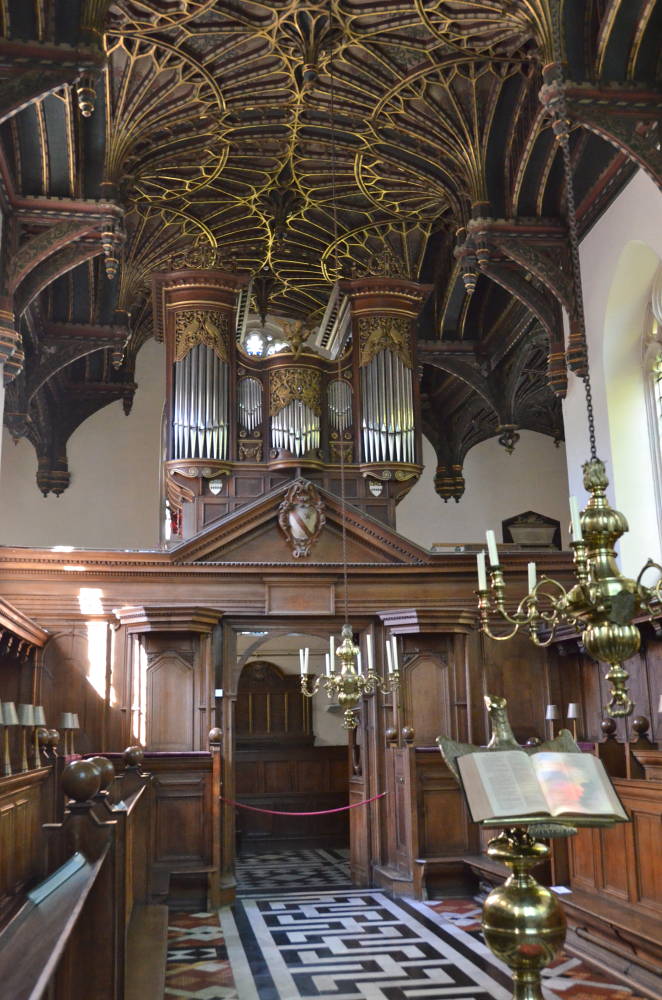
The Chapel, Brasenose College, Oxford. J. Mordaunt Crook explains that the College's first chapel,
only came into use in 1520 . . . in a space now occupied by the Senior Common room. . . . In 1656 Brasenose began to build a new chapel; in 1657-8 a new library and cloister. Here, in effect, was a new quadrangle, worthy of any of the smaller colleges of Oxford. Crucially, it was an enterprise that brought together both sides in the civil war. Collegiate loyalty came to count for more than the memory of political animosities. It was Radcliffe who had begun to work towards this goal, from the very start of his Principalship in i614. It was under Greenwood that the first stone of the chapel was laid on 18 June 1656. It was Yate who presided over consecration on 17 November 1666. Both sides in the war contributed to the building fund. Radcliffe's benefaction, as we shall see, was princely. Those of Yate and Greenwood were smaller, but symbolically significant. John Cartwright (parliamentarian) gave £120: his arms still decorate the organ screen. Thomas Church (royalist) gave £300, as well as a silver alms dish. Both sides in the recent troubles must have recognized that the college had come very close to collapse. Radcliffe, Greenwood, and Yate: parliamentarian, Presbyterian, royalist; loyalty to Brasenose proved in the end more powerful than the competing interests of all three. [19, 74]
In 1666 Simon White (who was paid 22 d a day) received 52 £ 10 s 0 d for laying the floor of the chapel and antechapel with black and white marble (77-78).
The Chapel Entrance



Left: Two views of the passage leading to the chapel. Right: An old monument or momento mori with cherubs blowing horns and skulls.


Left: A view from the chancel of the entrance and organ loft. Right: The entrance and organ loft seen from the choir stalls.
Brasenose secured right to dismantle and renove the interior of the old chapel of St. Mary's College (“later the site of Frewin hall”), and the materials salvaged from St, Mary's “dictated the form of the new building. Second-hand windows, second-hand roofing:” John Jackson, the master mason and architect, in charge of the construction “had to cut his conception according to his cloth. At the same time, no architectural statement in Oxford could afford to ignore the current visual conventions: . . . the survival of Gothic and the importation of Baroque. Hence the style—the perplexing, intriguingly hybrid style—of Brasenose College chapel. . . . The early sixteenth-century hammer-beamed roof, imported from old St Mary's, has been ingeniously disguised by a hanging fan vault of wood and plaster. [Crook 79]
In 1845 Philip Hardwick replaced the “decayed tracery of the Easy window.” (79n). Kempe and Mills did the decorative marble flooring and wall colouring in 1901, and Kempe did much of the stained glass and painting in 1894-96 and 1901.


Kempe's elaborately carved, painted, and gilded ceiling. “Originally covered in ‘whiteening”’, this ceiling was decorated by J. C. Buckler in 1859-60, and redecorated by C. E. Kempe in 1891” (Plate 54 caption).



Other images of Brasenose College, Oxford
- Exterior viewed from Radcliffe Square
- Exterior of the college viewed from the High
- The Old Quad
- The New Quad
- Deer Park
- The Hall
- Stained Glass
- Brasenose College, Oxford: Why “Brasenose”?
References
Crook, J. Mordaunt. Brasenose: The Biography of An Oxford College. Oxford: Oxford University press, 2008. [review by George P. Landow]
Last modified 20 August 2012